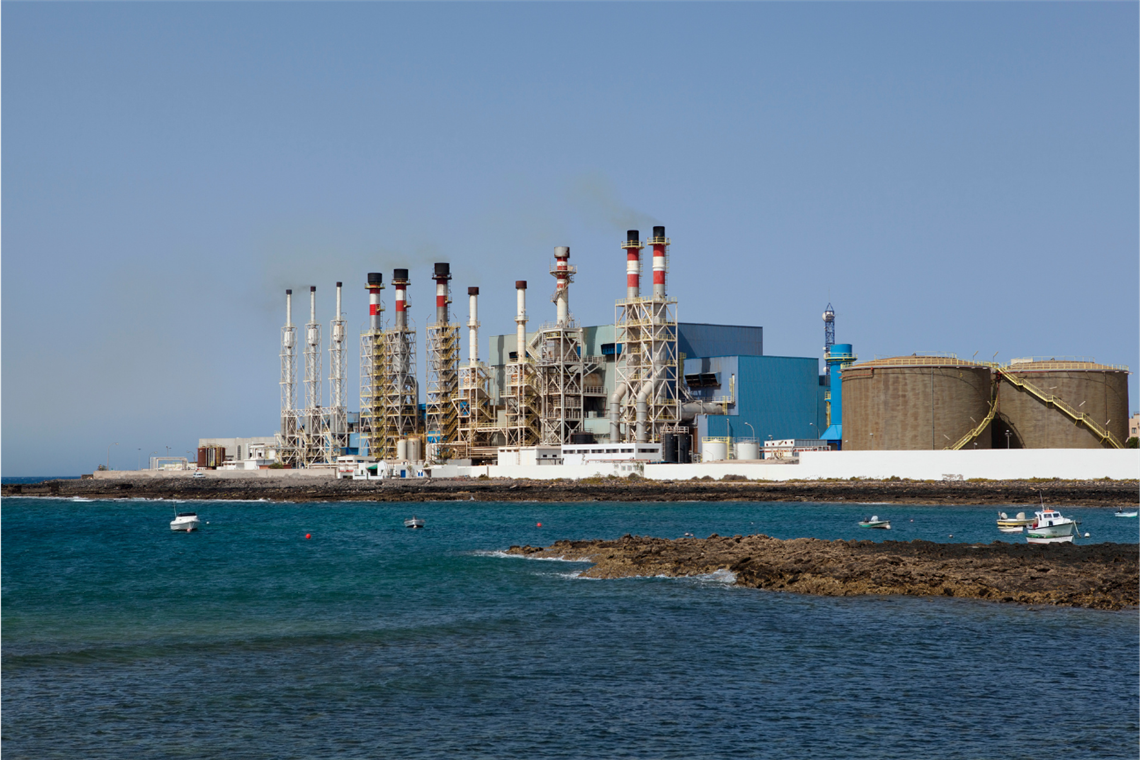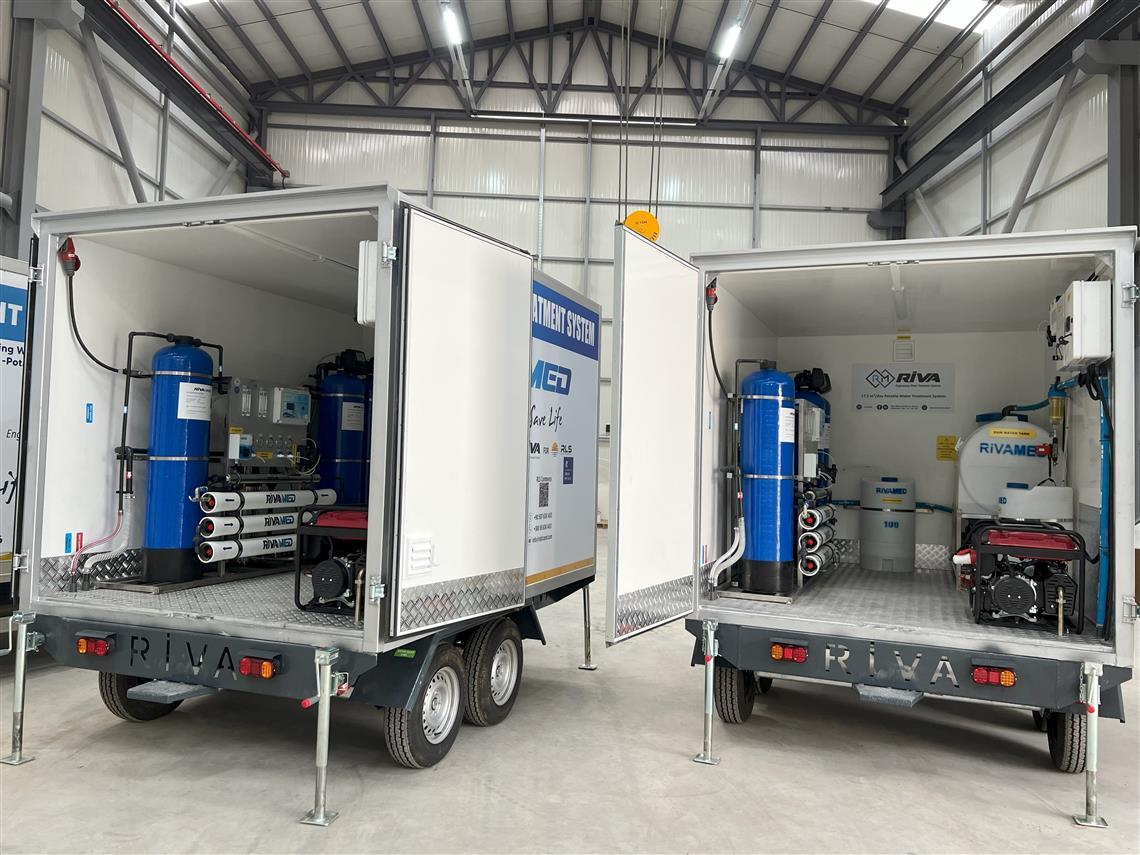Desalination is purifying salty seawater that effectively filters and removes salt, minerals, and other harmful substances in the water. Essentially, the desalination process relies on separating salt molecules in the water through a membrane.
Reverse Osmosis: An Effective and Efficient Purification Method
Reverse osmosis is one of the most commonly used methods of seawater purification. This method passes water through a semi-permeable membrane that blocks particles such as salt while allowing water molecules to pass freely. Reverse osmosis is known for its energy efficiency and effective salt removal.
Basic Principles of Reverse Osmosis
- Most desalination applications rely on the reverse osmosis method. Reverse osmosis is based on applying pressure to pass water through a semi-permeable membrane. This membrane allows the passage of water molecules while blocking the passage of salt, minerals, and other harmful substances. As a result, salty seawater is transformed into clean drinking water.
Role of the Semi-Permeable Membrane
- The semi-permeable membrane used in reverse osmosis has a structure with microscopic pores. These pores allow the passage of water molecules while retaining particles like salt. The membrane selectively allows the passage of water while leaving salt and other harmful substances behind, completing the purification process.
Microstructure of the Membrane
- The pore sizes of semi-permeable membranes are typically on the nanometer scale. Reverse osmosis membranes are specially designed to allow the passage of water molecules while preventing the passage of salt molecules. The pore diameters can typically range from 0.1 nanometers to 10 nanometers. For example, the pore size of a reverse osmosis membrane is generally around 0.5 nanometers.
Pressurized Water Flow
- The reverse osmosis process involves passing water through the semi-permeable membrane. This process is typically achieved through a high-pressure water flow provided by a pump. For instance, the pressure value can range from 70 to 120 bars. In reverse osmosis, high pressure is required for water to pass through the semi-permeable membrane. Usually, water provided by a pump is directed to the membrane through a high-pressure hose. This pressure must be high enough to push water molecules from the salty to the clean water side.
Pressure Exerted Over Osmotic Pressure
- The reverse osmosis process applies pressure higher than natural osmotic pressure that transfers water from the salty solution to the clean water. Osmotic pressure can be thought of as a force trying to prevent the passage of water from a salty environment to clean water. Osmotic pressure is usually lower. The reverse osmosis process applies pressure significantly higher than natural osmotic pressure. For example, the pressures used in seawater purification processes typically range from 40 to 70 bars. It is a pressure level much higher than osmotic pressure.
Efficiency in Separating Water and Salt
- The reverse osmosis system allows water to pass through the semi-permeable membrane while leaving salt and other harmful substances behind. Reverse osmosis systems generally have a recovery rate of around 30-50%, meaning that this percentage of the processed water becomes drinkable. For example, when 1000 liters of seawater are passed through a reverse osmosis system, 300 to 500 liters of potable water can typically be obtained.
Pore Size and Selectivity
- The membrane's pore size is optimized to allow the passage of water molecules while blocking salt molecules. Pore sizes can vary from the nanometer to the micrometer scale. For example, the pore size in a reverse osmosis membrane is typically between 0.005 nanometers and 0.5 nanometers.
High Pressure and Water
- Flow The reverse osmosis process occurs under high pressure. This pressure allows water to pass through the membrane, separating water on the salty side and pushing it to the clean water side to initiate the separation process. This high pressure surpasses natural osmotic pressure, enabling the passage of salt and other substances through the membrane.
Desalination in seawater is often carried out with high-pressure pumps and reverse osmosis systems. These systems pass water through a semi-permeable membrane and push water from the salty side to the clean water side.
High-Pressure Pumps
- The most commonly used pumps for the desalination process are typically high-pressure pump systems. Piston or diaphragm pumps are often preferred. High-pressure pumps provide the necessary pressure to push water through the membrane and separate the salty part of the water from the clean part.
Pump Type and Capacity
- A high-pressure piston pump or diaphragm pump can be used. • Example Capacity: 150 liters/minute* High-pressure piston or diaphragm pumps are commonly used in seawater purification systems. These pumps are used to generate high-pressure water and efficiently carry out the reverse osmosis process.
The specified capacity of 150 liters per minute may represent the average flow rate of a pump. However, the capacity can vary depending on the pump model, facility size, design parameters, and other factors.
Therefore, the selection of the appropriate pump type and capacity for a specific seawater purification plant should be based on the needs and requirements of the project. Thus, choosing equipment for a particular project requires expert engineering evaluation.
Pressure Values
- Pressure values vary depending on the type and features of pumps used in the desalination process. Typically, pressure values can range from 40 to 70 bars. For example, some modern desalination plants' high-pressure pumps can generate 80 bars or higher pressures.
Forward Osmotic Pressure (FOP):
- Forward osmotic pressure is a significant parameter in the desalination process. This pressure triggers water movement from the semi-permeable membrane's salty side to the clean water side. Forward osmotic pressure plays a crucial role in pushing water and enabling salt passage through the membrane by exceeding osmotic pressure.
- The pressure value required for an effective water separation process in desalination.
- Example Forward Osmotic Pressure: 30 bars*
An example forward osmotic pressure value of 30 bars may represent the pressure level applied by high-pressure pumps commonly used in desalination. This pressure is necessary to push saltwater through the semi-permeable membrane towards clean water.
However, such values are general expressions and can vary based on the specific technology, system design, and application conditions. Therefore, designing or optimizing a seawater purification plant should consider specific project requirements and technical details.
Membrane Selectivity
- The membrane's capacity to allow the passage of water molecules and retain salt molecules.
- Example Selectivity Rate: >99%.
Using these pumps and pressure values ensures the effective implementation of the process to separate the salty part of the water from the clean part and obtain drinkable water. Proper selection and operation of high-pressure pumps enhance the efficiency of desalination plants and are crucial for providing sustainable drinking water sources.
Energy Efficiency
- Desalination technology, especially the reverse osmosis method, is also distinguished by its energy efficiency. It consumes less energy than other desalination methods, enabling the purification of large amounts of water with lower energy consumption, offering an environmentally friendly and economical solution.
Energy Consumption
- The amount of energy used for pump operation and pressure generation.
- Example Energy Consumption: 3 kWh/m³*
This value represents the energy expended for pump operation and the production of high-pressure water. However, this value can vary from project to project, depending on the technology used.
Applications of Seawater Desalination Systems
Combatting Water Scarcity
Seawater desalination systems are critical in solving water scarcity, especially in coastal areas and deserts where water resources are limited. They offer an effective solution in the battle against water scarcity.
Water scarcity is a significant challenge in areas with limited water resources, particularly in coastal regions and deserts. Seawater desalination systems play a critical role in providing a solution for water supply in these challenging environments, offering an effective solution to combat water scarcity.
Water Supply in Coastal Areas
Seawater desalination systems become a vital source of water supply when water resources are limited in coastal areas. Despite being located near the sea, coastal regions often require desalination and reverse osmosis technologies to make seawater potable. These systems play a crucial role in providing reliable drinking water to communities residing in coastal areas.
Alternative Solution for Water Scarcity in Deserts
Deserts are often characterized by extremely limited water resources, and traditional water supply methods are challenging. Seawater desalination systems provide an effective alternative solution for combating water scarcity in deserts. By purifying seawater in coastal desert regions, these systems have the potential to supply water to local communities and industrial facilities.
Innovative Solution for Sustainable Water Supply
Seawater desalination systems offer an innovative solution for sustainable water supply in regions with limited water resources. By extracting and purifying water from the seas, these systems provide a reliable source of drinking water for local communities. They can also be used for agriculture and industrial activities, contributing to economic and social development in water-scarce regions.

Climate Change and Water Resources
As pressure on water resources increases due to climate change, seawater desalination systems emerge as part of climate change adaptation. Embracing these systems as a resilient water supply strategy in water scarcity regions will play a significant role in future water resource management.
Seawater desalination systems support environmental and economic sustainability in combating water scarcity, serving as a crucial tool for a livable future. The widespread adoption of these systems will empower communities in water-scarce regions and enhance the efficient use of water resources.
Industrial Uses
Industries such as energy production, oil, and gas require high-quality water. Seawater desalination systems contribute to industrial applications by providing water supply and increasing production efficiency.
Emergency Interventions
After natural disasters or crises, mobile seawater desalination systems can be rapidly deployed. These systems are vital for providing drinking water in emergencies.

The Future of Water Supply Solutions
Seawater desalination systems offer a sustainable solution where various filtration units and reverse osmosis come together. These technologies are crucial to addressing diminishing water resources and increasing water scarcity. In the future, these innovations in water supply will continue to play a significant role in combating water scarcity worldwide. Seawater desalination systems contribute to a sustainable future by helping overcome challenges in water supply.
Rivatec and Rivamed: Innovation and Quality in Seawater Desalination Systems
Rivatec and Rivamed are prominent manufacturers of industrial water treatment systems, making a name for themselves in the industry. Specializing in seawater desalination systems, desalination, and reverse osmosis water treatment technologies, they provide groundbreaking solutions for sustainable water supply.
Desalination Technology
Rivatec and Rivamed's desalination systems effectively filter salt, minerals, and other harmful substances from water to obtain potable water. Advanced solutions in membrane technologies make the water treatment process more efficient and environmentally friendly.
In addressing water supply challenges in regions facing water scarcity and industrial sectors, Rivatec and Rivamed are making future-oriented investments. By providing solutions for water supply with seawater desalination systems, they continue to set industry standards by combining technological leadership, customer satisfaction, and environmental sustainability principles.